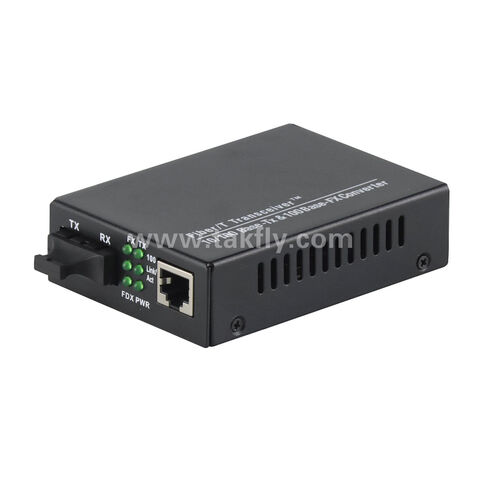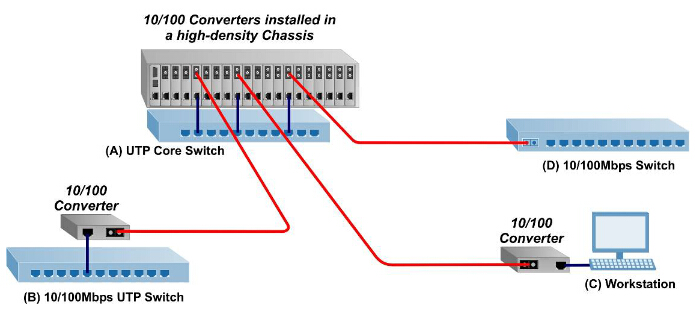

On the opposite sides of three ports, there’s a simple DC power plug. The LEDs can provide you information about the status your network, ranging from connectivity to power. Beyond that, the front face of the device consists of the mini-GBIC port, Ethernet port, on/off switch, and six indicator LEDs. The topside is highlighted by the StarTech logo, and the sides have a couple of ventilation holes. True to form, it can also connect an Ethernet network alongside a fiber backbone to integrate all your remote devices into one system. The converter itself was constructed inside a sturdy metal housing, which was engineered to provide years of lasting performance. The StarTech Gigabit Fiber Converter measures 6.2 x 3.6 x 1.8 inches, a reasonably compact design that vaguely resembles a smaller router. This particular gigabit Ethernet fiber media converter is capable of carrying your signal as far as 1804ft. Those variations primarily vary based on the distance you need to transmit your signal. Their Gigabit Ethernet Fiber Media Converter is actually available in six different variants. Because you tend to get what you pay for with these adapters. Partially because StarTech makes a huge number of quality adapters, and partially because those adapters often get fantastic reviews.
FIBER MEDIA CONVERTER PC
Though this brand isn’t exactly a household name, in the world of PC adapters, StarTech has a cult following. That might include support for copper RJ-45 cables, UPT, coax cables, single or multimode fiber connections, and so on.

How can you connect the fiber media converter? With the right gear, your potential options are almost limitless. However, you might want to stop and consider if you intend to use a single mode fiber optic cable, a dual strand cable, or a single strand cable. Because if you’re not careful, it’s easy to end up picking an Ethernet fiber media converter which doesn’t support the type of network you’re running.īasic compatibility concerns almost don’t need to be mentioned.

This is one detail that actually does matter. Most Ethernet networks will use 10/100Mbps, 10/100/1000Mbps, or the 1000Mbps network standard. If you’re not thinking about operating the equipment in those kinds of extreme environments, then you can stick with commercial gear. They can survive freezing temperatures, too. Industrial grade media converters are filled in hot, humid, electrically busy environments. You generally don’t have to think about commercial vs industrial grade equipment, with one exception. Managed fiber media converters tend to cost a bit more, but they include remote configuration and have network managing tools that can make your life a bit easier. The second are standalone converters, and converters that can be installed into a larger chassis of converters in a greater system. The first is a PC card fiber media converter, which is installed directly into a computer. There are typically three common form factors for Ethernet fiber media converters. Otherwise, you can focus primarily on data rate, compatibility, and connectivity concerns. If you’re picking a converter to be used in an array, you should think about the form factor. Data transmitted over fiber optic cable is immune to EMI noise, ensuring optimal data transmission across the plant floor.Picking the right Ethernet fiber media converter isn’t nearly as tough as all the stuff the converter has to manage. This interference can cause corruption of data over copper-based Ethernet links. An Ethernet to Fiber Media Converter can also be used where there is high level of electromagnetic interference (EMI) which is a common phenomenon found in industrial plants. By using an Ethernet to fiber conversion solution, fiber optic cabling can be used to extend this link over a greater distance.

The benefits include, extending Ethernet links over greater distances, protecting data from noise and interference, and future proofing a network with additional bandwidth capacity.Ĭopper-based Ethernet connections are limited to a data transmission distance of only 100 meters when using unshielded twisted pair ( UTP ) cable. These Media Converters are used to enable connections of UTP copper-based Ethernet equipment to various optical fiber cable such as multimode, single mode, or single strand fiber. Fiber to Ethernet Converters use a copper transceiver to transform the signal from a UTP / RJ45 Ethernet link to one that can be used by a fiber optic transceiver.


 0 kommentar(er)
0 kommentar(er)
